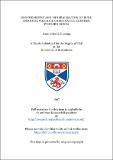Geochemistry and mineralization of Buru and Kuge volcanic carbonatite centres, Western Kenya
Abstract
Western Kenya hosts a number of Tertiary and Quaternary alkaline volcanic carbonatite centres, such as Rangwa, the North and South Ruri centres, Kuge, Homa Mountain and Legetet which are located along an old Precambrian major shear zone lying within the Nyanza rift, off the main Kenyan (Gregory) rift. The centres consist of agglomerates and breccias with mixed clasts of silicate rocks and carbonatites, interbedded with carbonatitic and nephelinitic tuffs. The volcanic assemblage is transected by high level sheets and dykes of calcite carbonatite and ferrocarbonatite which were probably later feeders for the volcanic eruptions. Carbon, oxygen, and sulphur isotopic compositions were determined for calcite, siderite and barite from the Buru and Kuge carbonatite centres. Wide ranges in the isotopic compositions of the minerals were observed with values for delta13C and delta18O for the Buru calcites ranging from +1.27 to -3.23‰ (PDB) and +11.25 to +26.21‰ (SMOW). The delta13 C and delta18O for the Kuge calcites are -3.11 to -8.44‰ (PDB) and +18.09 to +25.73‰ (SMOW). The Buru siderites plot in a narrow and restricted range at -3.07 to -4.39‰ (PDB) and +12.61 to +16.10‰ (SMOW). Data on the sulphur isotopic composition from the Buru hill carbonatite show a fairly widespread variation in delta34S ranging from +4.50 to +12.40‰ (CDT), whereas Kuge hill displays a slightly more homogenous isotopic composition with values ranging from +1.10 to +5.10‰ (CDT). The carbon and oxygen isotopic compositions from the Buru and Kuge carbonatite centres do not retain the primary isotopic signatures expected for magmatic primary carbonatites. Most of the variations in isotopic composition have been attributed to secondary processes involving low temperature (60° to 144°C) hydrothemal alteration and isotopic exchange between the carbonatites and fluids (meteoric water). Higher delta18O values (+21.91 to +26.21‰) with a significant increase in delta13Cvalues (-1.48 to +1.27‰) shown by the most oxidized samples from the Buru carbonatite may indicate the involvement of supergene exchange with atmospheric CO2 at relatively lower temperatures (<50°C). The variations in 34S shown by the two centres compared to mantle sulphur could be due to either redox processes and/or isotopic fractionations due to loss of volatiles. The Buru and Kuge carbonatite centres are characterized by enriched rare earth element (REE) values dominated by higher abundances of LREEs with steep chondrite-normalized distribution patterns. The lateritic zone at Buru hill, however, contains the greatest concentrations of REEs, barium, iron and manganese compared to the fresh carbonatite in which calcite and particularly siderite increase in abundance as the influence of supergene processes decrease with depth. The most common rare earth minerals encountered in the Buru and Kuge carbonatite centres are the fluorocarbonates (bastnaesite, synchysite and parisite), and monazite. The lanthanide fluorocarbonate and monazite control the concentration and bulk distribution of the REEs. The replacement textures of the lanthanide fluorocarbonates and monazite indicate that they are secondary in origin and appear to have been introduced by late stage, low temperature hydrothermal processes. The rare earth minerals are commonly accompanied by fluorite, and barite. Stable isotope studies suggest that the low temperature mineralogical changes and REE mineralization observed in western Kenyan carbonatites were controlled initially by hydrothermal activity and later by supergene processes. Higher delta18O and values, especially in the oxidized zones, correspond to higher REE abundances.
Type
Thesis, PhD Doctor of Philosophy
Collections
Items in the St Andrews Research Repository are protected by copyright, with all rights reserved, unless otherwise indicated.

